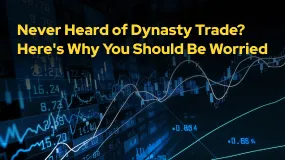简体中文
繁體中文
English
Pусский
日本語
ภาษาไทย
Tiếng Việt
Bahasa Indonesia
Español
हिन्दी
Filippiiniläinen
Français
Deutsch
Português
Türkçe
한국어
العربية
Why Studying A Lot Doesn’t Work | When Technical Analysis Fails
Abstract:Technical analysis is the go-to toolkit for countless investors. Candlestick patterns, moving averages, MACD signals, Elliott Waves—you name it, there’s a chart or model for it. Many spend years perfecting their craft, poring over price patterns and back testing strategies. Yet, despite all this effort, a large number still lose money. The reason? It’s not the tools as they’re merely instruments. It’s the human behind them that falters. In particular, wishful thinking and emotional bias often sabotage disciplined execution.

Technical analysis is the go-to toolkit for countless investors. Candlestick patterns, moving averages, MACD signals, Elliott Waves—you name it, there‘s a chart or model for it. Many spend years perfecting their craft, poring over price patterns and back testing strategies. Yet, despite all this effort, a large number still lose money. The reason? It’s not the tools as they‘re merely instruments. It’s the human behind them that falters. In particular, wishful thinking and emotional bias often sabotage disciplined execution.

1. Its a Game of Probabilities, Not Certainties
At its core, technical analysis is probabilistic. Indicators like support and resistance levels or moving average crossovers rely on historical patterns, not guaranteed outcomes. But markets are driven by human behaviour, which is always irrational. Greed, fear, and hope can disrupt even the most well-defined technical setup.
Take a textbook breakout, for instance. A stock breaks through a neckline, indicating bullish momentum. But just as traders pile in, major players might deliberately reverse course, triggering a sharp decline. In such moments, textbook theory collides with market reality.
2. The Perils of Overfitting
Many traders fall into the trap of over-optimising their indicators, tweaking variables in search of the elusive ‘perfect’ signal. But markets evolve. A strategy that performed well in a past bull run might be obsolete in a downturn. The 2015 Chinese stock market crash was a harsh reminder: countless traders believed in the mantra “a bull market never tops” until they were blindsided by a brutal collapse.
3. Black Swan Events Ignore Your Charts
Technical analysis falters in the face of unpredictability. Policy shifts, corporate fraud, geopolitical conflicts will not be priced into your moving averages. When U.S. crude oil futures turned negative in 2020, no chart could have seen it coming. In such moments, statistical patterns become irrelevant.

While technical indicators provide signals, the real battleground is psychological. Traders often know what to do, but fail to act.
1. Ignoring Stop-Loss Signals
The discipline to cut losses is foundational. Yet many traders, driven by the hope of a rebound, delay action. “Just wait, itll bounce back,” they say. A minor dip deepens into a painful loss. Studies show that over 90% of retail investor losses stem from an inability to exit losing positions in time.
2. Greed Overrides Exit Strategies
On the flip side, profitable trades are held too long. Technical signals advise caution with divergences, fading volume, but greed whispers, “It can go higher.”
3. Averaging Down into the Abyss
Technical discipline advises trading with the trend. But the urge to lower ones average cost leads traders to buy more as prices fall. The result? Compounding losses.
4. The Allure of Frequent Trades
Technical analysis should enhance precision, not encourage impulsivity. Yet overconfidence often leads to hyperactive trading. Ironically, higher trade frequency correlates with greater losses.
In summary, technical analysis is a sharp blade as it can be capable, precise, and powerful. But in the hands of a trembling trader ruled by hope, it becomes dangerous. Ultimately, the most successful market participants are not the most technically proficient, but the most disciplined.
Markets reward those who master their emotions, not those who master their charts.

Disclaimer:
The views in this article only represent the author's personal views, and do not constitute investment advice on this platform. This platform does not guarantee the accuracy, completeness and timeliness of the information in the article, and will not be liable for any loss caused by the use of or reliance on the information in the article.
Read more

Never Heard of Dynasty Trade? Here's Why You Should Be Worried
Have you heard this name before? No , it’s time you do because staying unaware could cost you. This platform is currently active in the forex trading and has been linked to several suspicious activities. Even if you’ve never dealt with it directly, there’s a chance it could reach out to you through ads, calls, messages, or social media. That’s why it’s important to know the red flags in advance.

Want to Deposit in the EVM Prime Platform? Stop Before You Lose It ALL
Contemplating forex investments in the EVM Prime platform? Think again! We empathize with those who have been bearing losses after losses with EVM Prime. We don't want you to be its next victim. Read this story that has investor complaints about EVM Prime.

WEEKLY SCAM BROKERS LIST IS OUT! Check it now
If you missed this week's fraud brokers list and are finding it difficult to track them one by one — don’t worry! We’ve brought together all the scam brokers you need to avoid, all in one place. Check this list now to stay alert and protect yourself from fraudulent brokers.

Catch the Latest Update on BotBro & Lavish Chaudhary
BotBro, an AI-based trading platform, became popular in India in 2024—but for negative reasons. Its founder, Lavish Chaudhary, who gained a huge following by promoting it heavily on social media. Since then, he has become well-known, but for many controversies. Let’s know the latest update about Botbro & Lavish Chaudhary.
WikiFX Broker
Latest News
WEEKLY SCAM BROKERS LIST IS OUT! Check it now
Apex Trader Funding is an Unregulated Firm | You Must Know the Risks
What WikiFX Found When It Looked Into Aron Markets
Textiles to whisky: U.K.–India 'historic' deal is set to boost bilateral trade by over $34 billion a year
Thailand-Cambodia border clashes: Cambodia's economy has more to lose, analysts say
Puma shares plunge 18% after full-year sales, profit outlook cut on U.S. tariffs
Is Your Forex Strategy Failing? Here’s When to Change
FSMA Warns That Some Firms Operate as Pyramid Schemes
Federal Reserve likely to hold interest rates steady despite pressure from Trump. Here's what that means for your money
Sigma-One Capital Scam? Investors Say They Can’t Withdraw Funds
Currency Calculator


